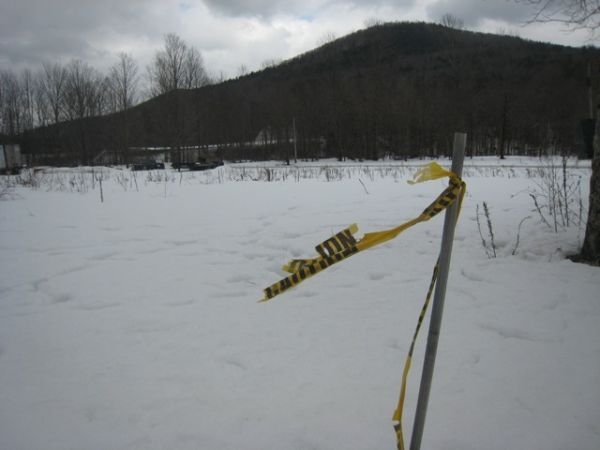
When the 2011 flood receded many Vermonters didn’t wait for government help. Residents and volunteers hauled away mud, debris and even flood-damaged homes that were on the brink of collapse. But people who cleared away property may not be eligible for federal funds.
66-year-old Nioka Andrews grew up in a little farmhouse his father bought on Route 100 in Pittsfield that had withstood the 1927 flood.
"When he bought the place he had to put all new floors in the downstairs part because they were totally gone," said Andrews, "on account of the ’27 flood. You know, it wasn’t a million dollar house by no means, but it was a home!"
Later it became a home to Andrews’ daughter, Johanna and her two daughters.
Standing next to the empty lot where his granddaughters once played, Andrews says the 2011 flood proved too much for the house.
"It broke the walls apart and the ceiling," recalled Andrews. "And that of course was letting rain water in and all kinds of stuff like that there. By the time the water receded there was about three feet of water in the house."
Other homes in Pittsfield were also destroyed. And the storm knocked out bridges, isolating residents for days. It was a traumatic time.
About a month later, Andrews and his daughter attended a meeting and talked to a FEMA representative.
"We asked about if we could tear the house down," said Andrews. "And he says there was no reason why not."
Pittsfield’s Administrative Officer took a look at the house and later, in a letter to the state, wrote the house was "unstable, open to the elements and… unsafe".
In October the Pittsfield library donated two empty dumpsters to Nioka Andrews and he tore down his house.
North of Pittsfield, in Braintree, the floodwaters left another house leaning, hovering over a brook.
Tim Caulfield, chair of Braintree’s selectboard, said someone from FEMA came to inspect it soon after the flood.
"He looked at the house and went into utility room and refused to go any further because he considered it unsafe," said Caulfield. "He wrote down in his report house destroyed, the foundation was undercut on three sides, and all walls of house were compromised, as he put it."

Caulfield said town officials told the owner they thought it could be dangerous.
"If the house washed down the stream it would compromise culverts and bridges and then be a safety hazard to the town workmen," said Caulfield.
"He [the owner] made decision and the town made a decision that it was best if it were torn down and he went ahead and tore it down about the end of October."
At around the same time, Lee Julich, the owner of Green’s Trailer Park on the White River in Sharon, tore down her two mobile homes.
"They were off the foundations," said Julich. "They were filled with mud. The insides were totally, totally devastated."
Julich was concerned about mold, safety and her liability. So when the town of Sharon organized volunteers to clear away debris and donated dumpsters she demolished her two units. But when the town applied to FEMA for a grant to buy the destroyed trailer park, the agency said it wasn’t eligible.
"The reason that I was given was that because the units were taken away," said Julich. "Because I chose to be pro-active and I was given no guidance and I had to fend for myself, and that’s how I felt. And I got punished for it!"
The homes taken down in Braintree and in Pittsfield were also deemed not eligible for the federal program that buys back flood-damaged properties in order to reduce future flood hazards.
Richard Verville, who oversees the FEMA Hazard Mitigation Program in New England, says the question of whether to demolish homes came up with the state as early as mid September after the flood.
"We made it very clear to the state," said Verville. "We were talking with Ray Doherty and he agreed that none of the properties were going to be demolished prior to the grant award, when we met with him. I think we met with him in the November right after the event."
Ray Doherty, Vermont’s Hazard Mitigation officer said the state was aware of FEMA’s rules and tried to get the word out as quickly as possible after the flood, but couldn’t reach everyone.
"In the chaotic aftermath of the storm, most towns and many homeowners were not aware of the FEMA regulations regarding the Hazard Mitigation Grant Program," recalled Doherty. "They were dealing with things they had to do immediately to safeguard their property, their belongings and they took those actions."
Meanwhile the state has appealed FEMA’s decision. Thad Leugemors works for SAIC, a consulting firm, hired by the state to assist towns applying to the Hazard Mitigation program. Leugemors said after a 2009 flood in the state of Georgia, FEMA approved funding for homes that were previously demolished, after it was shown they were taken down to reduce health and safety risks.
"FEMA still allowed the buyout to go forward because you still don’t want to see development on those sites," said Leugemors. "I made the recommendation that it should be appealed because a) I feel it’s right and b) the past precedent and I think the policy can allow for it."
Back in Pittsfield, for Nioka Andrews, talking about the flood still brings tears.
"I think what hurts the most really is just the way the FEMA is treating everybody," said Andrews. "If they didn’t want us to tear our houses down you would have thought they’d come around to everybody right after the flood and told us that, but they never gave us information like that at all!"
Many of the flood-damaged properties that FEMA did approve are still standing, but communities say they’re an eyesore.
The property owners who cleared away their homes are waiting for word on the appeal. FEMA has until early May to decide.